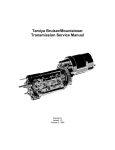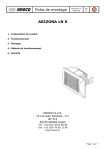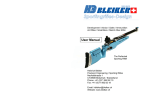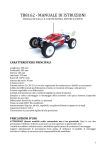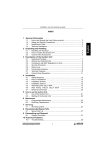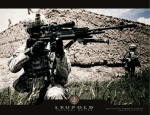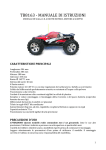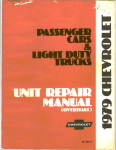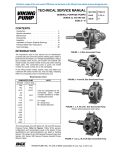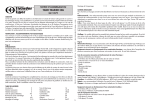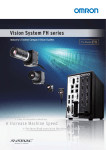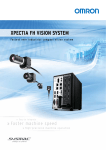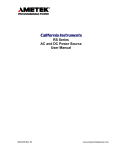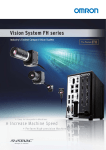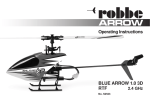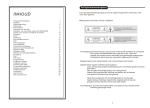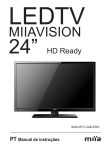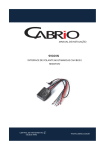Download Tamiya Bruiser/Mountaineer Transmission Service Manual
Transcript
Tamiya Bruiser/Mountaineer Transmission Service Manual Ko-ping Hu Version 1.03 First published October 5, 1999 Revised April 15, 2003 Table of Contents 1. 2. 3. 4. 5. 6. 7. 8. Introduction............................................................................................................ 3 Background ........................................................................................................... 3 Setup and Operation ............................................................................................ 3 Parts List................................................................................................................ 7 Ball Bearings Retrofit............................................................................................ 7 Naming Conventions ............................................................................................ 9 Disassembly........................................................................................................ 10 Modifying the Transmission for Full-Time 4WD............................................... 22 Tamiya Bruiser/Mountaineer Transmission Service Manual 1. Introduction This is all original research done by myself with my own transmissions. I decided to write this document to benefit other Tamiya Bruiser/Mountaineer enthusiasts. In the past I used my own handwritten notes and pictures for my personal use, and realized that there aren’t any good reference material of this kind. This can be a good reference material if you decide to rebuild/modify your transmission, or retrofit with ball bearings. Although this was based on the Bruiser/Mountaineer transmission, it is also applicable to the Toyota 4x4 HiLux and Blazing Blazer. A note of caution: Try not to lose anything inside the transmission. Aside from the Plastic Gear and some common bearings, none of the internal parts are available separately. You'll have to scavenge from another transmission or make your own. Use this document at your own risk. Although I’ve checked the instructions, your results may vary, and I'm not responsible for any damage you may cause to your transmission or your truck due to the use of this material. 2. Background This is a Tamiya 3-speed transmission with integral transfer case, made for certain vehicles in Tamiya’s line of 1/10 scale radio-controlled 4WD vehicles. For the Bruiser/Mountaineer, it uses a Mabuchi RS750SH electric motor for power. For the Toyota 4x4 Pickup (HiLux) and Blazing Blazer, it uses a RS540 electric motor. Shifting can be done manually or via a servo, acting upon the shift rail protruding from the end. The basic transmission (mated to either RS540 or RS750 motors) have been used in the following Tamiya vehicles: • Toyota 4x4 Pickup, RA-1028 (1982-1985) • Blazing Blazer, RA-1029 (1982-1984) • Bruiser, 58048 (1986-1992) • Mountaineer, 58111 (1993-1996) 3. Setup and Operation I have included the relevant sections from a Mountaineer Manual for reference. To summarize: Shift arm: • Pulled out = 4WD Low • Neutral = 2WD Medium • Pushed in = 2WD High Initially, a space of 8-10mm is left between the shift arm and the transmission. Version 1.03 Copyright 1999-2007 Ko-ping Hu Page 3 of 25 Tamiya Bruiser/Mountaineer Transmission Service Manual Figure 1: Attaching transmission parts Version 1.03 Copyright 1999-2007 Ko-ping Hu Page 4 of 25 Tamiya Bruiser/Mountaineer Transmission Service Manual Figure 2: Gear shift operation and adjustment Version 1.03 Copyright 1999-2007 Ko-ping Hu Page 5 of 25 Tamiya Bruiser/Mountaineer Transmission Service Manual You should waterproof your transmission by applying silicone sealant to the gaps between each section. This also keeps dirt out and lubricants in. Note: I do not know of any easy way to remove dried silicone sealant from a used transmission. It seems to be impervious to most household thinners and solvents such as paint thinner, lacquer thinner, kerosene, etc. Figure 3: Sealing the transmission Version 1.03 Copyright 1999-2007 Ko-ping Hu Page 6 of 25 Tamiya Bruiser/Mountaineer Transmission Service Manual 4. Parts List Tamiya included an exploded diagram in some of their kits. If you need a copy of one, you can get it from this URL: http://www.kope.com/bruiser/Exploded.pdf Part No. Name Quantity 1 Motor Housing (Transmission Case A) 1 2 3 Transmission Case B Transmission Case C 1 1 4 5 Transmission Case D Transmission Case E 1 1 6 7 RS-750SH Motor (with Pinion) Plastic Idler Gear (Counter Gear) 1 1 8 Main Gear Cluster 1 9 10 2nd Speed Countershaft and Gear Unit Low Speed Countershaft and Gear Unit 1 1 11 12 18T Idler Gear Front Drive Countergear 1 1 13 Front Drive Countershaft 1 14 15 Front Drive Shaft and Gear Unit Shift Fork A 1 1 16 17 Shift Fork B Shift Rail 2 1 18 19 Shifting Rings Shift Spring A 3 1 20 Shift Spring B 1 21 22 Shift Spring C 5x12.5mm Bushing 1 2 23 24 5mm Bronze Bearings 5mm Flange Bearings 4 8 25 Dust Protector 1 26 27 3x10mm Cap Screws 3x14mm Cap Screws 5 7 28 29 3x18mm Cap Screw 3mm Flange Nut 1 1 30 4x11mm Screw 2 5. Ball Bearings Retrofit If you plan to install ball bearings, you'll need: • Eight (8) 850 (5x8mm) Flanged bearings (e.g. Duratrax DTXC1527) • Five (5) 1150 (5x11mm) bearings • Shims. This can be a package of Calandra 5mm Axle Shims (can be difficult to find), or Traxxas 5x8mm Fiber Washers (#1985) (available at Tower Hobbies or your local hobby shop). You might see “*” in various parts of this document. See notes below • 2.5mm hex wrench * Notes: 1. The shims are necessary because the there is a difference in the flange thickness between the original bronze bushings and the ball bearings. We need to preserve that clearance; otherwise the transmission won't shift properly. Also, the flanged bearings are Version 1.03 Copyright 1999-2007 Ko-ping Hu Page 7 of 25 Tamiya Bruiser/Mountaineer Transmission Service Manual typically adjacent to some non-spinning surface, and without some kind of spacer to keep the flange from rubbing that surface; you're not totally reducing friction. Ideally, the shims should have an inside diameter of 5mm, and outside diameter of 6 to 6.5mm (smaller than the outer ballrace of the bearing). Figure 4: 850 Flanged Bushing and 850 Flanged Ball Bearing • • • • Each 850 flanged bushing is about 4.05mm thick. The flange is about 1.05mm thick. Each Duratrax 850 flanged ball bearing is about 2.48mm thick. The flange is about 0.59mm thick. There is a difference of 0.46mm between the flange thicknesses. You can round this up to 0.50mm for convenience. We are not worried about the thickness of the bearing itself. Each of the Calandra shims is about .12mm thick. To make up for the difference in flange thickness, you need about 4 shims. You may have to measure the flange thickness difference and adjust the number of shims as required in your case. 2. There will be some areas where it won't be possible to retrofit the bushings without modifications or specialized presses, so you'll just have to lubricate those bronze bushings well. I’ve used Slick 50, a PTFE additive used in automobiles and motorcycles. You can also use BreakFree CLP, available in hardware stores and gun shops. Tamiya’s instruction manual advises against using grease. Version 1.03 Copyright 1999-2007 Ko-ping Hu Page 8 of 25 Tamiya Bruiser/Mountaineer Transmission Service Manual 6. Naming Conventions I follow the naming conventions found in the exploded diagram of the transmission. The transmission can be divided into 5 sections. Starting from the motor, we have the Motor Housing (Transmission Case A), then Transmission Case B, Transmission Case C, Transmission Case D, Transmission Case E. Transmission Case C is the one that looks like 2 sections fused together. Figure 5: Left side of transmission Figure 6: Right side of transmission Version 1.03 Copyright 1999-2007 Ko-ping Hu Page 9 of 25 Tamiya Bruiser/Mountaineer Transmission Service Manual 7. Disassembly Here is a typical Bruiser transmission. The gap between each of the transmission sections is usually sealed with silicone sealant to (1) keep lubricant in, and (2) keep dirt out. There are 3 oil holes in the transmission. New Tamiya replacement rubber caps are no longer available, but similar aftermarket replacements are available – you’ll have to be resourceful and find what works. You may find suitable rubber/neoprene “feet” in electronics supply stores, or rubber caps in auto parts stores to plug/seal those 8mm diameter holes. You can even use duct tape. Occasionally, you may find people selling these parts on eBay. Figure 7: A typical used transmission Version 1.03 Copyright 1999-2007 Ko-ping Hu Page 10 of 25 Tamiya Bruiser/Mountaineer Transmission Service Manual Disassembly of the Motor Housing Side. Start by removing the motor. Picture below is with the motor removed. This is the Motor Housing (Transmission Case A). This is the side that the motor pinion goes into. Figure 8: Front of transmission – the Motor Housing (motor/input side) Removal of the Motor Housing. You need to remove 3 hex screws - two 3x10mm and one 3x15mm. Note the orientation of the Dust Protector (the white, plastic crescent-shaped piece). The side with 4 protrusions faces the screws. There is an 1150 bushing in the cover. The Plastic (spur) Gear can now be exposed. Figure 9: Transmission with Motor Housing removed Version 1.03 Copyright 1999-2007 Ko-ping Hu Page 11 of 25 Tamiya Bruiser/Mountaineer Transmission Service Manual Figure 10: Detail photo of the Plastic Gear and Dust Protector This is the Plastic (spur) Gear. This is Tamiya part number 4265002 (no longer available from Tamiya). I’ve found Kyosho’s one-piece transmission gear from part #BB006 (Big Brute/USA-1) can be adapted to fit (check Tower Hobbies). The Kyosho part does not have a slipper clutch. Figure 11: The Plastic Gear is supported by two 850 flanged bushings. Version 1.03 Copyright 1999-2007 Ko-ping Hu Page 12 of 25 Tamiya Bruiser/Mountaineer Transmission Service Manual Figure 12: Plastic (spur) Gear. This side faces the motor This is the other side of the Plastic Gear. Note the non-adjustable slipper mechanism. If you are retrofitting with bearings, I recommend 2 shims* on either side of the flange. Version 1.03 Copyright 1999-2007 Ko-ping Hu Page 13 of 25 Tamiya Bruiser/Mountaineer Transmission Service Manual Figure 13 Transmission Case B. This is what's underneath the Plastic Gear. Figure 14 Version 1.03 Copyright 1999-2007 Ko-ping Hu Page 14 of 25 Tamiya Bruiser/Mountaineer Transmission Service Manual Disassembly of Transmission Case B: Part 1 Remove Transmission Case B by loosening three 3x15mm hex screws. Be careful - the cover is under spring tension. Do not lose that spring. Figure 15 Here is the side view of the transmission with Transmission Case B removed. I’ve replaced the Plastic (spur) Gear to show the relationship of the gears. Figure 16 Version 1.03 Copyright 1999-2007 Ko-ping Hu Page 15 of 25 Tamiya Bruiser/Mountaineer Transmission Service Manual Disassembly of Transmission Case B: Part 2. Picture shows Transmission Case B removed. Parts are shown with the correct orientation. Don't lose that Shift Spring A (15mm spring). The 2nd Speed Countershaft (the shaft with gears on each end) is supported by two (2) 850 flanged bushings. If retrofitting with ball bearings, use 5 shims* between the gear and the bearing flange. Figure 17 Disassembly is now complete with this end. Re-assemble (if desired) before continuing on. The Output Side of the Transmission – Transmission Case E Figure 18 Version 1.03 Copyright 1999-2007 Ko-ping Hu Page 16 of 25 Tamiya Bruiser/Mountaineer Transmission Service Manual Transmission Case E (End Plate) Removal Remove Transmission Case E by loosening three 3x15mm hex screws. The Transmission Case E is under spring tension. Don’t lose that spring. The Other Side of the Transmission Case E (End Plate). The bushings are either stuck here or on the shafts below. There are recesses for two (2) 1150 and one (1) 850F bushings. When you reassemble this part, you might find it easier to mount the 3 bearings/bushings back in the Transmission Case E (End Plate). Figure 19 Disassembly of Transmission Case D Carefully remove the Front Drive Shaft and Gear Unit from Transmission Case D. You may directly replace the 1150 bushings with 1150 ball bearings. I would use rubber sealed ball bearings (at least on the output side of the shaft). Figure 20 Version 1.03 Copyright 1999-2007 Ko-ping Hu Page 17 of 25 Tamiya Bruiser/Mountaineer Transmission Service Manual The Front Drive Countergear Assembly. Exploded view of the Front Drive Countergear (the one screwed onto the End Plate). I do not know of any ball bearings that replaces the Plastic bushing. Figure 21 Disassembly of the Transmission Case D – Continued Remove the following parts: Main Gear Cluster, Shift Rail assembly (lift out the entire thing), Low Speed Countershaft and Gear Unit. Parts are shown in the correct orientation below (Figure 22). Figure 22 The Shift Rail assembly is assembled in the following manner: Shift Rail (pointed side in), Shift Fork B(flat side against the stop), Shift Spring B (9mm spring), Shift Fork B (flat side out), 5x12.5mm Bushing, Shift Spring C (32mm spring). See picture below for correct orientation. Note the Low Speed Countershaft and Gear Unit (the one with 2 gears and a metal tube) is oriented with the long shaft pointing out. Version 1.03 Copyright 1999-2007 Ko-ping Hu Page 18 of 25 Tamiya Bruiser/Mountaineer Transmission Service Manual Another picture of the internal parts and their orientation. Figure 23 There are a couple of bushings in here. If retrofitting with ball bearings, for each 850 flanged bearing use 5 shims between the flange and its adjacent surface. Figure 24 Transmission Case D can be unbolted from Transmission Case C by removing three 3x10mm hex screws. Version 1.03 Copyright 1999-2007 Ko-ping Hu Page 19 of 25 Tamiya Bruiser/Mountaineer Transmission Service Manual This is what an empty Transmission Case C looks like after removing everything inside Transmission Case D (looking from the output end). Figure 25 Version 1.03 Copyright 1999-2007 Ko-ping Hu Page 20 of 25 Tamiya Bruiser/Mountaineer Transmission Service Manual This is the other end (looking from the input/motor side) of an empty Transmission Case C. While it may be possible to remove the gear cluster inside Transmission Case C, I chose not to do so in this document. There is another bushing inside the gear cluster, but I just leave it as-is. Figure 26 This is a completely disassembled transmission. Figure 27 Version 1.03 Copyright 1999-2007 Ko-ping Hu Page 21 of 25 Tamiya Bruiser/Mountaineer Transmission Service Manual End of Disassembly The transmission can be re-assembled in the reverse order. I find it easier to reinstall the parts in Transmission Case C/D in the following order: 1. It is not necessary to attach Transmission Case D to Transmission Case C first. You can do it either now or after you reinstall the internals – up to you. 2. Low Speed Countershaft and Gear Unit Assembly. 3. Shift Rail with one Shift Fork B, along with one Shifting Ring. 4. Shift Spring B. 5. Main Gear Cluster. 6. The other Shift Fork B, and the other Shifting Ring. 7. Everything else. 8. Modifying the Transmission for Full-Time 4WD The stock transmission only operates in 4WD in Low gear. It is possible to modify the transmission to have full-time 4WD. If you study the power flow diagram (Figure 2), you will see that the Front Drive Shaft and Gear Unit Assembly meshes with the Front Drive Countergear, which meshes with the 18T Idler Gear. Since the 18T Idler Gear is decoupled from the Main Gear Cluster (except in Low Gear), no power is transmitted to the front output shaft. When you shift into Low gear (by pulling out the Shift Rail), the (outer) Shift Fork B slides the (outer) Shifting Ring between the Main Gear Cluster and the 18T Idler Gear, thereby connecting the two. Once this connection is made, power is transmitted to the front output shaft. Obviously, shifting into Low gear does more than just that – it also engages the Low Speed Countershaft and Gear Unit Assembly. It would be helpful to study Figure 24 – specifically the arrangement of the Shift Rail Assembly. You will note that the two Shift Forks basically move in unison (the Shift Springs B and C are there to maintain the required distance between the Shift Forks, and to provide a little “give” if the gears do not engage). Please see Figure 28 and 29 for a better idea of gear engagements. Figure 28: Medium Gear (unmodified) Version 1.03 Copyright 1999-2007 Ko-ping Hu Page 22 of 25 Tamiya Bruiser/Mountaineer Transmission Service Manual Figure 29: Low Gear (unmodified) The key is to keep the outer Shift Fork B fixed in relation to the 18T idler Gear and the Main Gear Cluster so that the associated Shifting Ring connects the two, while at the same time allow the Shift Rail to move in and out to engage Medium and High gears. One way to do this is to modify the arrangements of the elements on the Shift Rail a bit. A little fine-tuning may be required, but I will give you the general idea: 1. You need the (outer) Shift Fork B fixed in place, so that it always connects the 18T Idler Gear with the Main Gear Cluster. If you take Shift Spring C out, and just leave the 5x12.5mm Bushing (the hollow metal tube) in place, you’re pretty close. 2. You need to push the (inner) Shift Fork B away from the (outer) Shift Fork B. In other words, you need a longer spring between the two Shift Forks than the original Shift Spring B. This spring will: (1) Keep the (outer) Shift Fork B against the Bushing, (2) Keep the (inner) Shift Fork B away so that it does not stay in Low or Medium gear, if you push the Shift Rail in to select High gear. (3) Compress enough between the two Shift Forks so that you can still shift into Low gear. They two Shift Forks are about 16 to 17mm apart depending on the slop in the transmission. This spring should probably be about twice as long as the Shift Spring B. You might find that Shift Spring C will work in its place. Reassemble and manually test the transmission (turn by hand and shift by hand). If the spring is too long to work properly then you will have to find a suitably shorter one. 3. You will lose the ability to shift from 2WD to 4WD. It may be possible to devise a shifter mechanism to operate the 2 Shift Forks independently, but I’ll leave it up to you to experiment. 4. You should retrofit all bushings with ball bearings. There is a little more driveline drag (friction) in 4WD mode, so it is advisable to run with ball bearings inside the transmission. Version 1.03 Copyright 1999-2007 Ko-ping Hu Page 23 of 25 Tamiya Bruiser/Mountaineer Transmission Service Manual Figure 30 shows the modified Shift Rail arrangement. Ideally, when Low gear is engaged, the spring between the two Shift Forks should not be fully compressed as shown in the picture (there should have a little more slack available to aid gear engagement). If you want to experiment and need a donor spring, you may find a suitable one from a retractable ballpoint pen. Figure 30: Modified Shift Rail arrangement for full-time 4WD, Low gear engaged - End - Version 1.03 Copyright 1999-2007 Ko-ping Hu Page 24 of 25 Tamiya Bruiser/Mountaineer Transmission Service Manual Document History Date 10/5/1999 3/17/2003 4/15/2003 7/11/2007 Description Version 1.0 Version 1.01 – updated email address. Version 1.02 – Fixed missing picture in Fig.7, malformed email link. Version 1.03 – Updated copyright info. Copyright 1999-2007 Ko-ping Hu. All rights reserved. No part of this document may be reproduced, in any form or by any means, without permission in writing from the author. Other product and company names mentioned herein may be the trademarks of their respective owners. This version of the document is free for personal use. Please contact the author at [email protected] if you plan to use it for commercial purposes. This document is provided "AS IS" and without any warranty or condition, expressed, implied or statutory. By using this document at all, you're agreeing to abide by these terms. Distribution: Please provide a hyperlink back to the original document (in case I update the document people can always get the latest). The document may be found on http://www.kope.com/bruiser You may store a copy locally for your own use. In cases where hyperlinking is not feasible, I freely authorize the distribution of copies of this version of the document as long as the following conditions are met: 1. No fee is charged for the document. 2. The document is only distributed in its original form and is not altered in any way. 3. It is not included as part of another commercial offering. Version 1.03 Copyright 1999-2007 Ko-ping Hu Page 25 of 25

























